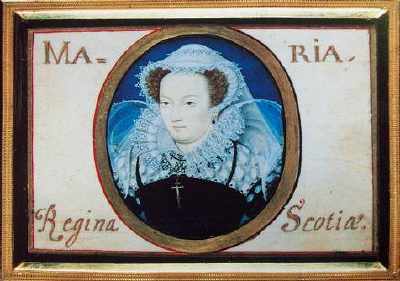Mary, Queen of Scots
Mary Stuart, Queen of Scots, lived a life very different from that of her cousin Elizabeth --her turbulent romances were in sharp contrast with the chaste image of the Virgin Queen.
Mary's ambitions for Elizabeth's throne stimulated Catholic unrest in England and ultimately led to her execution. Mary became Queen of Scotland when only six days old. As the granddaughter of Margaret Tudor, the elder sister of Henry VIII, Mary's claim to the English throne was technically even superior to that of Elizabeth. (Just as the hereditary claims of Edmund Mortimer and Richard of York in the 15th century were superior to those of the Lancastrians.)
Murders, plots . . .
Raised in France by her relatives and married* to the French Dauphin, Mary and her husband claimed title to England when he was crowned in 1559. Unfortunately for Mary, her husband's death the following year forced her return to Scotland.
There her unpopularity as a Catholic was worsened by scandalous romances* and complicity in her second husband's murder--the cause of her forced abdication and flight to England (see the next page).
After her arrival in England in 1568 Mary became the centre of successive plots to dethrone Elizabeth and restore Catholicism. However, it was only after the Babington Plot of 1586 that Elizabeth consented to Mary's trial, since written evidence proved explicitly her agreement to a planned assassination.
. . . And execution
Elizabeth still hesitated*, even after receiving a promise of non-interference from Mary's son, James VI. But her councillors finally prevailed; it was only their immediate action that prevented Elizabeth from countermanding her order to execute Mary.
Footnotes
-
Strategic marriage
Mary and the Dauphin were wedded under the agreement that both their kingdoms would be united if she bore a male heir, with a secret clause that Scotland would be ceded to France if she died without an heir.
-
Mary and Duessa
In Spenser's Faerie Queene the character Duessa [=double-being, or deceit] is a colourful representation of Mary Stuart's carnal appetite and false faith (Catholicism):
A goodly Lady clad in scarlot red,
Purfled with gold and pearle of rich assay,
And like a Persian mitre on her hed
She wore, with crownes and owches [brooches] garnished,
The which her lavish lovers to her gave;
. . .one Duessa a false sorceresse,
That many errant knights hath brought to
wretchednesse.
(Book 1. Canto 2. 110-114, 305-306) -
Defending an enemy
Elizabeth defended Mary for as long as she could; she was well aware of the forces challenging her own sovereign authority and remembered the dangers she lived through during her sister's reign as a result of plots by others on her behalf. But Mary was an active player, not an innocent pawn of others, and she lacked Elizabeth's caution and subtlety.
